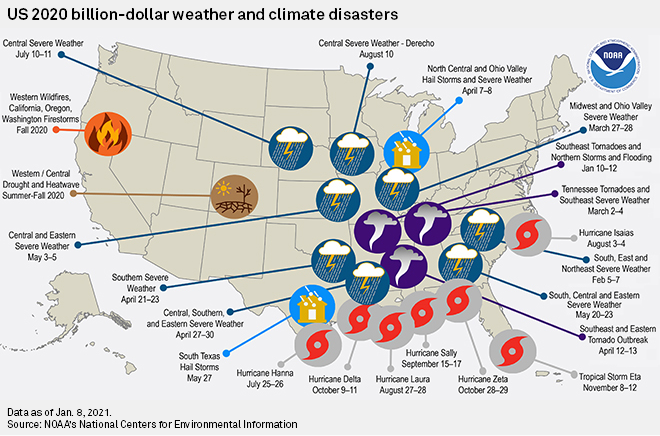S&P Global Offerings
Featured Topics
Featured Products
Events
S&P Global Offerings
Featured Topics
Featured Products
Events
S&P Global Offerings
Featured Topics
Featured Products
Events
Banking & Capital Markets
Economy & Finance
Energy Transition & Sustainability
Technology & Innovation
Podcasts & Newsletters
Banking & Capital Markets
Economy & Finance
Energy Transition & Sustainability
Technology & Innovation
Podcasts & Newsletters
S&P Global Offerings
Featured Topics
Featured Products
Events
8 Jan, 2021

By Esther Whieldon
The U.S. in 2020 experienced a record-smashing year in billion-dollar-scale extreme weather and climate change-linked disasters such as wildfires, tropical cyclones, tornados and hail storms, according to figures the National Oceanic and Atmospheric Administration released Jan. 8.
In 2020, the U.S. experienced 22 extreme weather and climate-exacerbated disasters that each had losses in excess of $1 billion. Those events collectively caused at least $95 billion in damages, killed at least 262 people and injured scores more, according to NOAA’s National Centers for Environmental Information.
The largest number of annual major disasters previously was 16, which occurred in 2011 and 2017. The figures for 2020 were also significantly higher than in 2019 when the U.S. experienced 14 major disasters that caused $45 billion in losses.
Scientists have projected that as average global temperatures continue to rise due to human-caused greenhouse gas emissions the number and intensity of extreme weather events would rapidly increase.

On the same day it issued the disaster tally, NOAA also published a summary of general weather trends in the U.S. in 2020. Overall, the average temperature across the contiguous U.S. in 2020 was 54.4 degrees F, which was 2.4 degrees above the 20th-century average and the fifth warmest year on record. NOAA noted that all five of the warmest years in the U.S. have been since 2012.
None of the lower-48 states experienced below-average annual temperatures in 2020. However, Alaska, despite its annual temperatures still being above its long-term average in 2020, experienced its coldest year since 2012.
As for precipitation, the Great Lakes and Plains to the Southeast and mid-Atlantic regions had above-average levels while much of the Western U.S. saw below-average precipitation and more areas experiencing drought conditions.
Some of the biggest billion-dollar disasters of 2020 included a widespread drought during the summer that hit more than a dozen Western and Central states, which also contributed to massive wildfires that burned more than 10.2 million acres largely in California, Oregon and Washington. The report estimates the wildfires cost about $16.5 billion.
But the most costly event of 2020 with $19 billion in damages and 42 deaths was Hurrican Laura in August that damaged water systems and the electric grid in southern Louisiana, NOAA reported.
Of the seven tropical cyclone billion-dollar disasters in 2020, the next two costly were Hurricane Sally in September that caused damage across Alabama, the Florida panhandle and into Georgia, and Hurricane Isaias that in August accelerated up the east coast and hit New York, New Jersey, and Pennsylvania.
But the Southeast and the Midwestern U.S. also experienced some major events, including a severe weather derecho wind event in August that traveled from Southeast South Dakota to Ohio that caused $11 billion in damages. Other major events include hail storms in the North Central and Ohio Valley, an outbreak in April of more than 140 tornados from Texas to Maryland, and high winds and hail across the Midwest and Ohio Valley in March.
The report comes out shortly after the German-headquartered insurance and reinsurance firm Munich Re found that natural catastrophes around the globe caused overall losses of $210 billion in 2020, about 60% of which was not covered by insurance.
